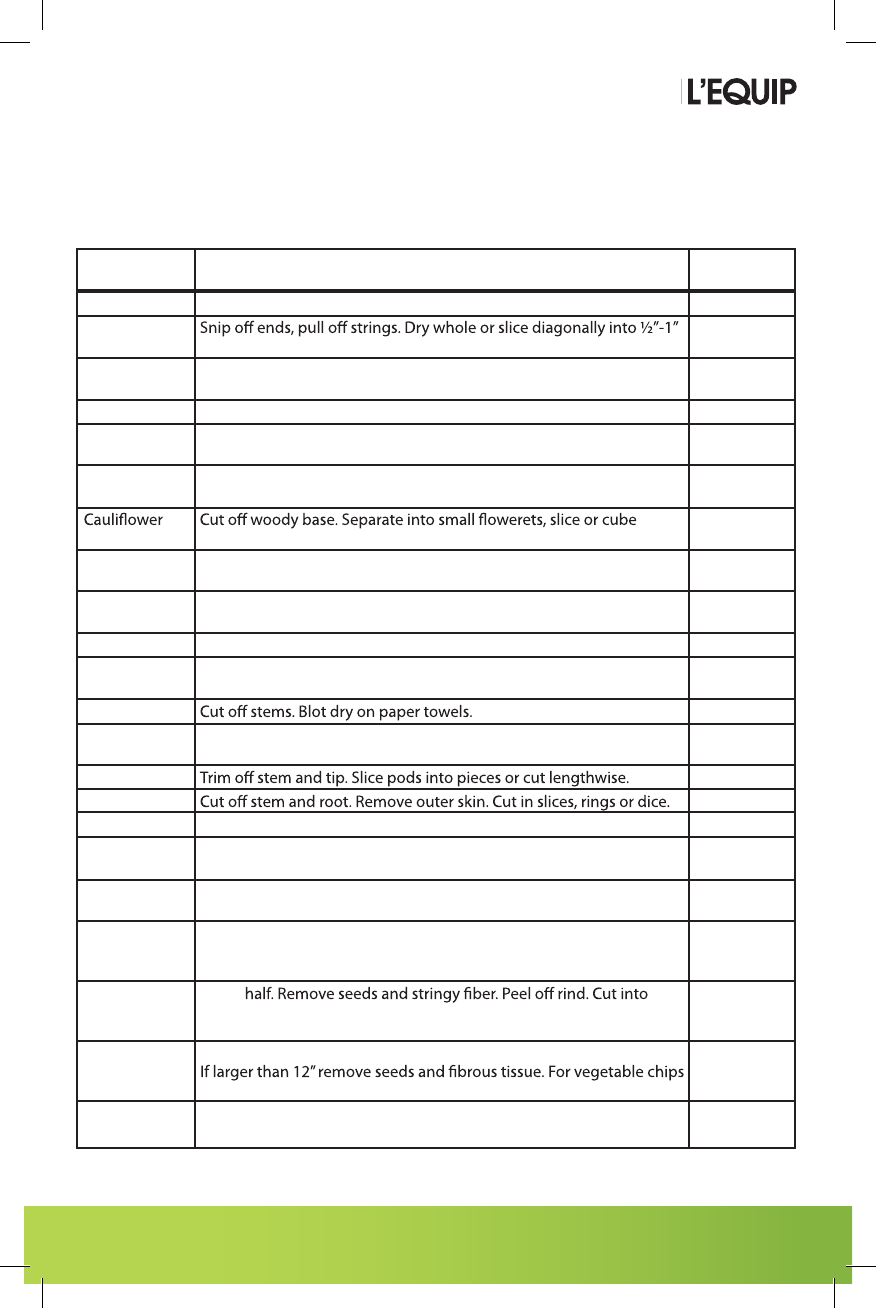
DEHYDRATOR
23
VEGETABLES
Dried vegetables are very versatile. Use them to make soups, stews, soués,
casseroles, and dips. They can also be used in recipes calling for fresh or canned
vegetables.
Preparation:
• Select fresh, rm, ripe vegetables that are free from blemishes. Tender green
beans, corn and peas are preferred. Celery, carrots and peppers should be
crisp. Dry as soon as possible after picking to retain the most nutrients.
• Wash vegetables thoroughly in cold water before processing.
• Trim, core, peel, slice or shred vegetables.
• If cutting vegetables into slices make sure they are a uniform size. ¼”- ½” are
best for drying.
• See section on PRETREATING for information about vegetables that need
to be steamed/blanched before dehydrating. Some vegetables require no
pretreatment. Blanching decreases drying time.
• Spread vegetables in a single layer, unless shredded or grated.
• Dry vegetables until there is no visible sign of moisture and they are brittle, hard,
or crisp. Peas should shatter when hit with a knife.
Vegetable Powders
Vegetables may be pureed, dried as leathers, and then powdered for making
juices, soup bases, dips, salad dressings, or baby foods. Dehydrate vegetable
leather until very brittle. Immediately powder small amounts at a time in a dry
blender. Brittle, sliced or chopped vegetables can also be powdered. Powders
must be stored in airtight containers to avoid clumping. Reconstituted pow-
dered tomatoes, for example, make great tomato sauce or pizza sauce. Remem-
ber powders have very concentrated avor.
Vegetable Chips
Vegetable chips oer a great crunchy texture and taste. Select vegetables such
as cucumbers, eggplants, zucchini, or parsnips. There is no need to peel. Cut
very thin slices (1/8” thick). Steam 3 or 4 minutes, if chips will be stored longer
than 5 months. Sprinkle generously with salt before drying. (Seasoned salts
make an interesting chip). Dry until very brittle. These can be served plain or
with dips.
Vegetable Preparation Avg. Dry
Time (Hrs)
Asparagus Remove woody end. Slice diagonally into ½”-1” pieces. Blanch/steam. 3 - 10
Green Beans 6 - 12
pieces or cut lengthwise. Blanch/steam.
Beets Steam until tender. Cool and peel. Cut in slices, cubes or shoestring 3 - 10
strips.
Broccoli Cut all stalks in halves or quarters. Blanch/steam. 4 - 10
Cabbage Trim outer leaves. Cut in half. Core. Cut into strips or dry whole leaves. 4 - 10
Blanch/steam.
Carrots Remove tops and stringy end. Peel, cut crosswise, lengthwise or 4 - 12
diagonally into slices, cubes or grate. Blanch/steam.
6 - 14
into pieces. Blanch/steam.
Celery Trim. Cut lengthwise or crosswise into strips or pieces. Leaves may 3 - 10
also be dried. Blanch/steam.
Corn Remove husk and silk. Blanch/steam. Plunge immediately into 6 - 12
cold water. When cool, drain. Cut kernels from cob.
Cucumbers Peel (skin is bitter when dried). Slice or shred. Salt, if desired. 4 - 10
Eggplants Trim. Peel. Cut into round slices, julienne strips or cubes. Blanch/ 4 - 14
steam. Skin may be dried separately.
Greens
4 - 10
Mushrooms Remove woody stems. Wipe with brush or cloth. Do not wash. 4 - 10
Slice or cube. Small mushrooms may be dried whole.
Okra
4 - 10
Onions 6 - 12
Peas Shell. Sort. Blanch/steam. 5 - 14
Peppers Remove stem and seed head. Cut in rings, strips or dice. Seeds may 5 - 12
also be dried. Blanch/steam. For seeds use leather sheets.
Potatoes Peel. Remove green lining just under skin. Cut away bruises. Cut into 4 - 12
slices, strips or grate. Blanch/steam.
Pumpkins Cut in half. Scrape away pulp and seeds. Remove rind. Cut into 6 - 12
wedges 1”-3” wide and then into strips ½” wide. Seeds can also be
dried. Blanch/steam.
Winter Squash Cut in
4 - 10
(Butternut, strips or cubes. Seeds may also be dried. Blanch/steam.
Acorn)
Summer Squash Peel if desired. Cut in slices, cube, julienne strips or coarsely grate. 4 - 10
(Zucchini)
soak in soy sauce before drying.
Tomatoes Remove stem area. Peel, if desired. Cut in slices. Blot excess 6 - 12
moisture before drying.
NOTE:
Dry vegetables at 135°. Use average times only as a general guideline.
Many variables can contribute to a large dierence in drying times.
Vegetables should contain only 5% moisture and should look and feel crisp
and brittle.


















